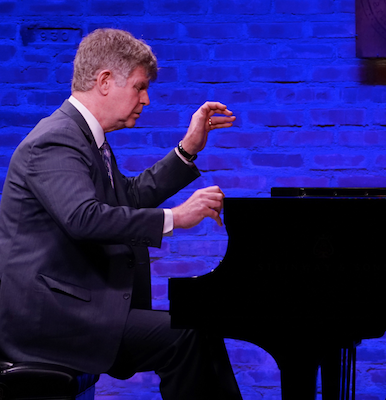Ian Hobson, Pianist in Review
Ian Hobson, piano
Merkin Concert Hall, Kaufman Center, New York, NY
April 13, 2016
Ian Hobson has unusual stamina. He plays with an uncanny virtuosity. His interpretations are nuanced and fresh. Of those elements, the stamina aspect cannot be overstated here. He opened with Fauré’s Theme and Variations, Op. 73, then proceeded with Chopin’s Etudes, Op. 10, followed by Schumann’s Symphonic Etudes, Op. 13, and then concluded with none other than Rachmaninoff’s Preludes, Op. 32. There was exceptional pacing within each work, and he never tired technically or emotionally.
Mr. Hobson’s interpretation of the Fauré had the usual simplicity and delicacy of the French master, but also the extroverted tenderness of a young Brahms. There was beauteous and varied tone here, exquisite balance of the hands–featuring supremely delicate high notes, and the phrasing was also unique, with a favorability for stretching musical lines into very long phrases. The Chopin had a fleet-fingered leggiero (lightness of touch) when called upon, as in the opening Allegros, but also a profoundly warmer tone quality as needed–like No. 3, the E major Lento. No. 5, the G-flat major Vivace, had expert timing, with the subtlest of rubato. Even more endearing tempo fluctuations were evident in No. 8, the F major Allegro. No. 4 was facile and precise, especially in the left hand. It was only in No. 11, that a few phrases were glossed over.
The Schumann Etudes, really a Theme and Variations, which Brahms would also master, is symphonic in ways that Schumann’s symphonies tried to be but couldn’t. Brahms achieved in his symphonies what Schumann lacked: varied colors and depth in the orchestration. Mr. Hobson performed this Schumann evoking an orchestra, seemingly turning left hand dotted rhythms into cellos and basses, sometimes a low brass section. In the fourth etude, the punctuated chords were pungent in a way that a woodwind section can pierce through a tonal fabric, and the lyrical right hand was reminiscent of violas, clarinets, and silky smooth violins on top. Emotionally speaking, there was a wonderful mix of relaxed moods and stormy agitato befitting Schumann’s inner torment. The memorable finale was fiery and propulsive–emotionally obsessive at times–with a welcome, exaggerated attention to harmonic detail, like when the chord pattern climactically changes to the major key–as in the end of Bolero, when it surprisingly shifts to E major. Hobson’s Rachmaninoff contained both soul and a soul-searching quality. The peaks were timed beautifully; during grandiose moments, the bass was powerful but never distorted or over-pedaled, as sometimes is the case. His encore was Rachmaninoff’s last work–from 1941, an arrangement of a Tchaikovsky Lullaby: the A-flat “Cradle Song” from Six Romances, Op. 16.

